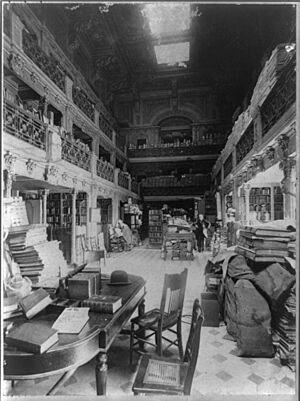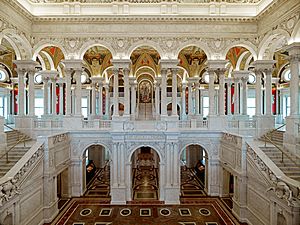Library of Congress facts for kids
Quick facts for kids Library of Congress |
|
|---|---|
 |
|
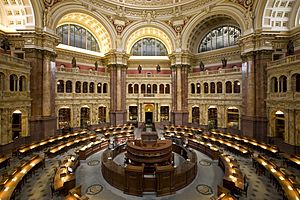 |
|
| Main reading room in the Thomas Jefferson Building at the Library of Congress | |
| Established | April 24, 1800 |
| Location | 101 Independence Ave., S.E., Washington, D.C., U.S. |
| Coordinates | 38°53′19″N 77°0′17″W / 38.88861°N 77.00472°W |
| Collection | |
| Size | 173 million items |
| Access and use | |
| Circulation | Onsite use only |
| Population served | Congress, citizens, and international visitors |
| Other information | |
| Budget | $802.128 million |
| Director | Robert Newlen, Acting |
| Staff | 3,105 |
The Library of Congress (often called LC or LOC) is a huge research library in Washington, D.C. It is the main library for the United States Congress and also acts as the national library of the United States. This means it's the country's most important library. It is also in charge of U.S. copyright laws through the United States Copyright Office.
Started in 1800, the Library of Congress is the oldest federal cultural institution in the U.S. It is so big that it fills three buildings on Capitol Hill in Washington, D.C., and has other storage locations as well. The library is one of the largest in the world, with over 173 million items and more than 3,000 employees. Its collection includes materials from all over the world in more than 470 languages.
The library's main job is to help Congress with research. However, it is also open to the public for research. While you can't check out books unless you work for the government, you can visit and use the materials inside the library.
Contents
History of the Library
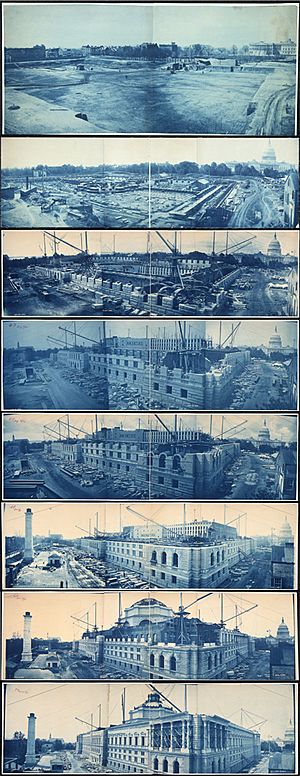
Early Years and Jefferson's Help
The idea for a library for Congress was first suggested in 1783 by James Madison, but it wasn't created until 1800. President John Adams signed a law that provided $5,000 to buy books from London. The first library had 740 books and three maps and was located inside the United States Capitol.
President Thomas Jefferson was very important to the library's growth. In 1802, he signed a law that allowed the president to choose the Librarian of Congress.
In 1814, during the War of 1812, British soldiers burned many government buildings in Washington, D.C., including the library. Over 3,000 books were destroyed. To help, Thomas Jefferson offered to sell his own personal library to Congress. In 1815, Congress paid him $23,950 for his 6,487 books. Jefferson's collection had books on many different subjects, which turned the library from a small, specialized one into a much larger, general library.
Fires and Slow Growth
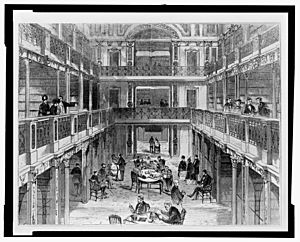
On Christmas Eve in 1851, a big fire destroyed about 35,000 books, which was two-thirds of the library's collection. This included many of the books from Jefferson's original collection. Congress paid to replace the lost books but didn't buy many new ones for a while.
During the 1850s, the library didn't grow much. However, things changed after the American Civil War. The government was growing, and Congress needed more information for its work. In 1866, the Smithsonian Institution gave its collection of 40,000 books to the Library of Congress after a fire in its own building.
A Time of Major Expansion
From 1865 to 1897, Librarian Ainsworth Rand Spofford worked hard to make the library a true national library. He got support to build a new, separate building for the library. He also helped pass a law that said the library would get two copies of every book, map, and photo published in the United States. This is called copyright deposit, and it helped the library grow very quickly.
By 1897, the library moved into its new home, now called the Thomas Jefferson Building. It had over 840,000 items. The staff grew from 42 to 108 people to manage the huge collection.
Becoming a Modern Library
In the early 20th century, under Librarian Herbert Putnam, the library continued to grow. By 1901, it had one million books. Putnam wanted the library to be useful to everyone. He started a service called interlibrary loan, which lets other libraries borrow books from the Library of Congress.
The library also bought many important collections from around the world. This included thousands of books from Russia, collections of early opera music, and works from China and Japan. In 1929, Congress approved the purchase of a very special collection that included a perfect copy of the Gutenberg Bible, one of the first books ever printed.
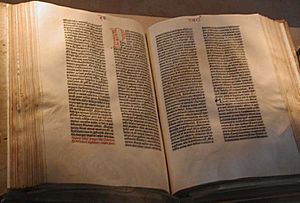
The library got so big that it needed more space. The John Adams Building was built and opened in 1939.
World War II and After
During World War II, the library helped the war effort. It even stored important documents like the Declaration of Independence and the United States Constitution in a safe location at Fort Knox.
After the war, the library set up missions around the world to collect books and other materials for American libraries. The library continued to grow, and by the 1970s, it needed even more space. The James Madison Memorial Building was built and opened in 1980.
The Digital Age and New Programs
From 1987 to 2015, Librarian James H. Billington led the library into the digital age. He started many new programs to make the library's collections available online.
- American Memory was launched in 1990 to digitize parts of the collection. Today, millions of items are available online for free.
- Congress.gov is a website started in 1994 that gives public access to information about U.S. laws.
- The National Book Festival began in 2001. It is a huge event that celebrates books and reading.
- The Veterans History Project was created in 2000 to collect and save the stories of American war veterans.
- The World Digital Library was launched in 2009. It shares cultural treasures from around the world online.
Recent Leadership
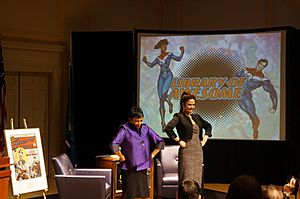
In 2016, Carla Hayden became the 14th Librarian of Congress. She was the first woman and the first African American to hold the position. She worked to make the library more modern and easier for everyone to access, especially online.
On May 8, 2025, President Donald Trump fired Hayden. The Principal Deputy Librarian Robert Newlen was also fired. The president named other officials to lead the library in the meantime.
What's Inside the Library?
The Library of Congress has an amazing collection of items. If you lined up all its bookshelves, they would stretch for over 838 miles! The collection includes:
- More than 39 million books in 470 languages.
- More than 61 million manuscripts (handwritten documents).
- The largest collection of rare books in North America, including a draft of the Declaration of Independence.
- One of only three perfect copies of the Gutenberg Bible printed on vellum (animal skin).
- Millions of maps, photographs, and pieces of sheet music.
- Over 140,000 issues of comic books.
- Famous musical instruments, like Stradivarius violins.
The library gets copies of almost every new item published in the U.S. because of the copyright law. It receives about 15,000 new items every day and adds around 12,000 of them to its permanent collection.
The Library's Buildings
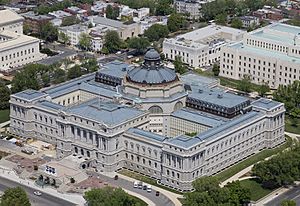
The Library of Congress has three main buildings on Capitol Hill. They are all connected by underground tunnels.
- Thomas Jefferson Building: Opened in 1897, this is the oldest and most famous building, known for its stunning art and architecture.
- John Adams Building: Opened in 1939, this building has a simpler, Art Deco style.
- James Madison Memorial Building: Opened in 1980, this is the largest of the three buildings.
The library also has a special facility in Culpeper, Virginia, called the National Audio-Visual Conservation Center. This center stores and protects the library's collection of movies, television shows, and sound recordings.
How to Use the Library
The library is open to the public for research. Anyone over 16 can get a Reader Identification Card to use the reading rooms. You can't take items out of the library, but you can study them there.
Since 1902, the Library of Congress has also loaned items to other libraries across the country. This makes it a "library of last resort," meaning other libraries can borrow from it when they can't find an item anywhere else.
Annual Events
- Gershwin Prize for Popular Song
- Library of Congress Prize for American Fiction
- National Book Festival
See also
 In Spanish: Biblioteca del Congreso de Estados Unidos para niños
In Spanish: Biblioteca del Congreso de Estados Unidos para niños
- Architecture of Washington, D.C.
- Documents Expediting Project
- Federal Research Division
- Feleky Collection
- Law Library of Congress
- Library of Congress Classification
- Library of Congress Country Studies
- Library of Congress Living Legend
- Library of Congress Subject Headings
- Minerva Initiative
- National Digital Library Program (NDLP)
- National Film Registry
- National Recording Registry
- National Archives and Records Administration
- United States Senate Library


